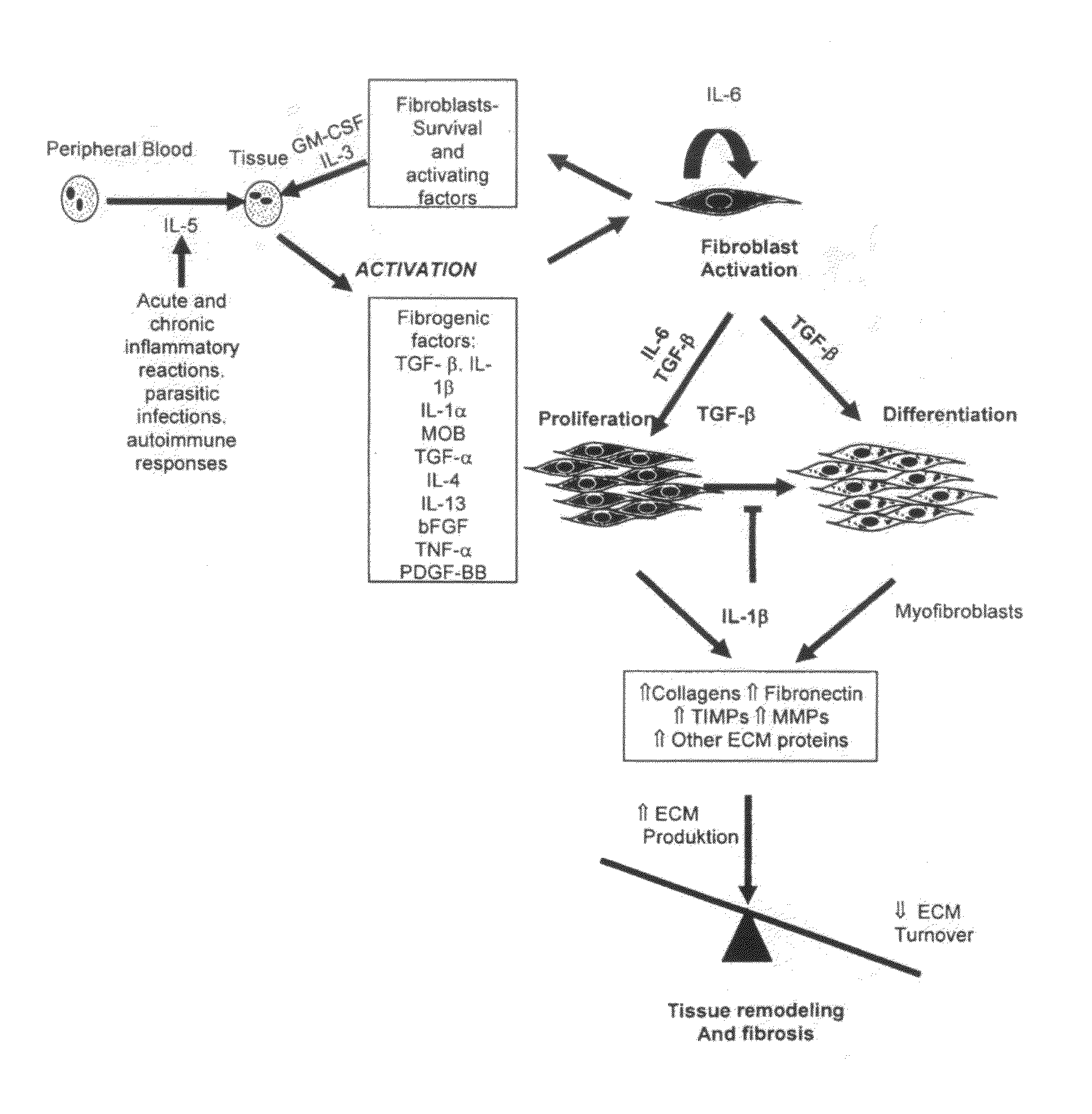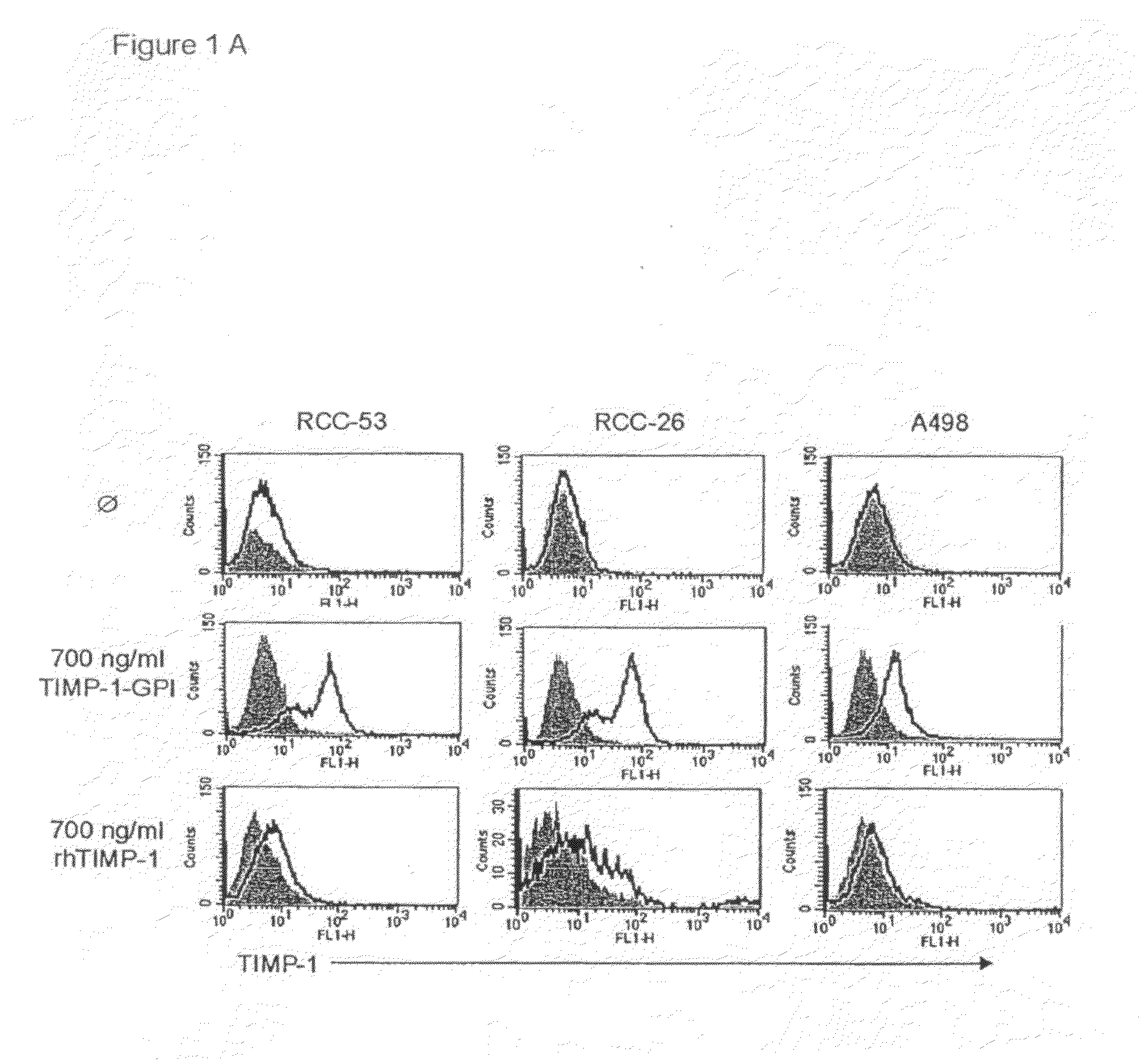Tissue Inhibitor of Metalloproteinases (Timp) Linked to Glycosylphosphatidylinositol (Gpi) - Anchors for Treatment of Cancer and Skin Lesions
a technology of glycosylphosphatidylinositol and tissue inhibitor, which is applied in the field of fusion constructs, can solve the problems of difficult elimination of tumor cells, difficult to develop cancer therapy strategies and approaches, and ineffective anti-tumor immunity that often fails to efficiently develop, so as to promote fibroblast differentiation, increase ecm production, and reduce ecm turnover
- Summary
- Abstract
- Description
- Claims
- Application Information
AI Technical Summary
Benefits of technology
Problems solved by technology
Method used
Image
Examples
example 1
[0153]Incorporation of Exogenously Added TIMP-1-GPI into the Surface of RCC-53
[0154]GPI-anchored TIMP-1 protein was generated and isolated as previously described (Djafarzadeh et al., 2004). The incorporation of purified GPI-TIMP-1 protein into the surface membranes of RCC-53, RCC-26 or A498 RCC cell lines was demonstrated by incubation of the cell lines with 700 ng / ml of purified TIMP-1-GPI or recombinant human (rh)TIMP-1 control protein for one hr. Surface associated TIMP-1 protein was then detected using FACS (FIG. 1A). Addition of control rhTIMP-1 did not lead to change in the FACS shift, however, GPI-anchored TIMP-1 resulted in a strong surface signal for TIMP-1.
[0155]To demonstrate that the exogenously added protein was GPI anchored, RCC-53 cells were first incubated with TIMP-1-GPI protein (200 or 700 ng / ml), and then treated with 60 ng / ml phospholipase C (PLC). FACS analysis demonstrated the complete loss of TIMP-1 cell surface signal following PLC digestion (FIG. 1B). To me...
example 2
[0156]TIMP-1-GPI Protein Blocks Release of proMMP-2 and proMMP-9 from RCC-53
[0157]An increased expression of MMP-2 and MMP-9 correlates with a poor prognosis of RCC (Hemmerlein et al., 2004). The stage IV clear cell carcinoma cell line RCC-53 constitutively secretes both proMMP-2 and proMMP-9 (FIG. 2). The effect of increasing surface TIMP-1 levels on the constitutive release of MMP-2 and MMP-9 proteins was tested using gelatinase zymography assays (Djafarzadeh et al., 2004; Klier et al., 2001). rhTIMP-1 protein at 600 or 1200 ng / ml had no effect on proMMP-2 or proMMP-9 secretion. In contrast, starting at 10 ng / ml, TIMP-1-GPI treatment showed a concentration-dependent decrease of both proMMP-2 and proMMP-9 release into the growth media.
example 3
[0158]Treatment with TIMP-1-GPI Leads to Increase in Surface Expression of matrix Metalloproteinases
[0159]Based on the results of the gelatinase zymography experiments, it is possible that TIMP-1-GPI may act to sequester MMPs on the cell surface. TIMP-1 binds most active forms of MMPs, the exceptions being MMP-14 and MMP-16 (Brew et al., 2000; Lang et al., 2004). Following incubation of RCC-53 with 700 ng / ml of TIMP-1-GPI protein for 24 h, FACS analyses using MMP-1, MMP-2, MMP-3, MMP-7, MMP-8, MMP-9, MMP-12, MMP-13, MMP-14, MMP-15 and MMP-16 specific antibodies showed, with the exception of MMP-14, an increase in mean channel fluorescence intensity (MFI) for each of the MMPs. rhTIMP-1 control protein had no obvious effect on the FACS signal (data not shown). The surface expression of other proteins including MHC class I (pan class I and HLA-A2) and ICAM-1 was not effected by TIMP-1-GPI treatment. Digestion of the TIMP-1-GPI treated RCC53 with PLC after one hour (as performed in FIG....
PUM
| Property | Measurement | Unit |
|---|---|---|
| concentration | aaaaa | aaaaa |
| concentration | aaaaa | aaaaa |
| molecular mass | aaaaa | aaaaa |
Abstract
Description
Claims
Application Information
 Login to View More
Login to View More - R&D
- Intellectual Property
- Life Sciences
- Materials
- Tech Scout
- Unparalleled Data Quality
- Higher Quality Content
- 60% Fewer Hallucinations
Browse by: Latest US Patents, China's latest patents, Technical Efficacy Thesaurus, Application Domain, Technology Topic, Popular Technical Reports.
© 2025 PatSnap. All rights reserved.Legal|Privacy policy|Modern Slavery Act Transparency Statement|Sitemap|About US| Contact US: help@patsnap.com



